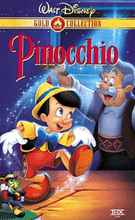Pinocchio

Synopsis of Movie
”When you wish upon a star,
Makes no difference who you are…”
It’s tempting to call Pinocchio the Citizen Kane of animated films, but not everyone likes Citizen Kane. No such problem with Pinocchio. From critics to laymen, from senior citizens to the most junior citizens, from every land across the globe, there are few human beings alive that haven't been enthralled with this precocious puppet’s quest to become a real boy.
Touching, terrifying and technically brilliant, this is the kind of film people sell souls to make. The fact that it came sandwiched on the Disney slate between two other titans of feature animation, Snow White and the Seven Dwarves and Fantasia, makes the achievement all the more incredible.
Carlo “Collodi” Lorenzini’s fable remains mostly intact in Disney’s version, although some of the darker elements have been expunged. Jiminy Cricket introduces the film, narrating the story of the lonely, childless wood-carver Geppetto. The aging man’s starlight wish is that his newest creation, a puppet named Pinocchio, could somehow become a real live boy.
This plea is answered in person by the lovely Blue Fairy, who with a wave of her wand gives the still-wooden puppet a life of its own. She tells the new child that if he proves himself good, honest and noble, one day he will become a real boy. The Fairy appoints Jiminy as the boy’s official conscience, then departs. Overjoyed, the puppet-maker welcomes the child into his home and sends him out to get a good education.
Pinocchio isn’t a bad boy, but he is easily tempted. Enter sly fox J. Worthington Foulfellow (a.k.a. "Honest John") and his doofus cat lackey Gideon. With the catchy tune, “An Actor’s Life for Me,” the two convince the puppet boy to give up schoolwork for a life in show business. The opportunistic animals sell the boy to puppet show impresario Stromboli, who puts the stringless puppet in his own act.
Pinocchio is a hit, but Stromboli is a cruel master, locking him up in a cage and promising a future at the end of an axe once he’s too old to perform. The Blue Fairy shows up to intervene, but when she asks how Pinocchio ended up in this fix, the child lies to save face. Suddenly Pinocchio gets some extra face, as his nose extends further and further with each mistruth. When the boy comes clean, the Fairy restores his normal nose and sets him free.
Unfortunately, Pinocchio hasn’t learned his lesson well enough. “Honest John” and Gideon again tempt the boy away from his studies, and on to Pleasure Island, a land where boys can smoke, drink beer and play as much billiards as they want. Pinocchio thinks he’s having a grand old time, but soon he and buddy Lampwick begin transforming into donkeys. Within a few horrifying moments, Lampwick converts into a complete jackass, rounded up with all the other boy/donkeys to work in the salt mines. With Jiminy’s help, Pinocchio escapes, but when the two return home, Geppetto is gone.
A note from the Blue Fairy tips Pinocchio and Jiminy off to the old man’s whereabouts: Out looking for his lost child, Geppetto’s raft was swallowed whole by the great whale Monstro. Boy and cricket take to the seas to find the whale, asking schools of fish at the bottom of the ocean if they’ve seen the beast. Eventually, the two are swallowed into the belly of the whale and reunited with Geppetto. The wood-carver thinks all is lost, but the boy has a clever and dangerous plan to escape.
With Pinocchio, the story was only part of the story. The film’s accomplishments and influence are too many and too great to quantify. Certainly, the songs are worthy of mention, from the Oscar-winning “When You Wish Upon a Star” to “Give a Little Whistle” and “I’ve Got No Strings.”
Equally important was the creation of a host of enduring characters—the puppet himself, the Blue Fairy, Figaro the cat (who went on to star in several Disney cartoon shorts), Stromboli and many others. Perhaps none has had as long a career as Jiminy Cricket, who became a sort of spokescricket for Disney. Jiminy hosted the 1947 feature Fun and Fancy Free, appeared in a number of shorts (including the “I’m No Fool” series) and eventually became a regular on TV’s The Mickey Mouse Club.
Pinocchio was more than creative; it was innovative. The advancements made by both Snow White and this film formed the basis for feature animation techniques that are still in use today. But all the artistic and technical achievements of Pinocchio would be mere historical footnotes if the film didn’t succeed in one all-important area: Pinocchio is spellbinding.
As dozens of successful re-releases in theaters and on video have proven, the movie will never go out of style, never stop appealing to new generations of kids, never stop entertaining those who grew up on it. In retrospect, maybe Citizen Kane is the Pinocchio of live-action movies.
Movie Release History
1940 - PinocchioMovie Sub Categories
animatedsci-fi/fantasy
musical
disney
Movie Studio
DisneyCast
Barker Don BrodieJ. Worthington Foulfellow Walter Catlett
Lampwick Frankie Darro
Jiminy Cricket Cliff Edwards
Pinocchio Dickie Jones
Stromboli Charles Judels
The Coachman Charles Judels
Geppetto Christian Rub
The Blue Fairy Evelyn Venable
